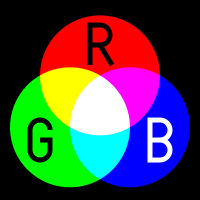A classmate uttered and invitation for me to talk about something I know a little something about.
And like any nerd, I erupted with information that most people probably don't even want to know. We can't help it. It's part of being a nerd. People think we're quiet and introverted. We're not. You just have nothing of any interest of us to say. Haha.
Strap in for some serious tl;dr. (Or skip to the end.)
"I still have a hard time understanding that the rules of light are different than the color, and understanding that they are entirely different things made out of the same colors. but isn't the color wheel made out of the colors of light. But i have a hard time anyway, since I am slightly color blind, well a little more slightly, but I manage."
 Colour is a property of light and not a property of the objects themselves. Light, which is a form of energy, works in waves, like all energy. The colours we see are the different wavelengths of light.
Colour is a property of light and not a property of the objects themselves. Light, which is a form of energy, works in waves, like all energy. The colours we see are the different wavelengths of light.Because waves have a length and frequency, light is used to measure the Universe. Hell, we don't call it the Universe anymore. We now call it the Observable universe because we've seen as far as we can possibly see in all directions. Objects past that point are expanding away from us faster than the speed of light, so we can never see them as the light from those objects will never reach us.
Visible light only exists in a very small set of wavelengths. Red is the longest we can see and blue is the shortest. As the link below states, anything bluer than blue, we can't see and call Ultraviolet. (Sound familiar?) We can't see redder than red either, or Infrared. (It's cool to know where all this comes from, isn't it?) Green is the most visible wavelength (notice it's right in the middle of the spectrum). This is why night vision appears green. It picks up the green light, which is easiest to see.
Our eyes have two kinds of receptor cells that allow us to see. Rods, which detect light and let us interpret value and Cones, which let us detect the wavelengths of light in the visible spectrum. Your colourblindness is due to having too few cones and inversely, I'm nightblind in one eye because I have too few rods in it.
All colours exist in sunlight, so we see it as white light. We see space as black because there is no light coming to us. This is why we can see the objects in space. They either reflect (dark bodies like planets) or emit light. This is also why we don't see the other side of the moon during the day. The same light is reflected off the moon at all times, but we're seeing the sky as bright due to to the atmosphere scattering light. This is part of why the sky looks blue during the day, and goes red, as the light vanishes and purple as it comes back. This is also why laser pointers are red. Since they have long wavelengths, they get the least interference from the air molecules and aren't scattered by the air. (The link below goes into detail).

Once you understand that colour is a property of light and not a property of the object, it's a lot easier to get the reflect/absorb thing.
A red crayon is absorbing all the other wavelengths of light except reds. Since the reds are the only colours that are allowed to bounce off the crayon, you see red.
A white shirt is letting all the colours bounce back, so you see white. This is also why you feel cooler wearing white. White reflects nearly all the light, therefore is reflecting back heat as well. A black shirt does the opposite, absorbing nearly all that light. (It's not accurate to say ALL of the light is absorbed. If no light it hitting your eye from the object, you can't see it. It would look like a void. If you could make a shirt that didn't reflect light, but also let it pass right through, you'd have an invisibility shirt. Haha. (Sorry, I'm a nerd. I love this stuff. Right now, I think they're experimenting with objects that don't reflect light, but show an image of what's behind it, thereby making it "invisible".)
The monitor is beaming light directly at you, rather than reflecting. That's really the only difference.
Here's some info on how it all goes down. (As an added note, notice that some waves don't penetrate the atmosphere? Someone else looking for us using those waves wouldn't see the surface of the planet. They'd just see the haze of the atmosphere, but they can make images of the earth's surface with radio waves.
Isn't it awesome!? *geeks out*
----------------------------
And it didn't stop there.
----------------------------
I'll geek a little m
 ore then, cause this is important.
ore then, cause this is important.It's already been said that you mix all the colours to make white light.
Notice that mixing one with the other, gives you the CMY in the CMYK.
Since it works by adding light to reflect to you to make white, it's called additive.
CMYK works by starting at white and removing light by covering the white with pigment. This causes more light to be absorbed and less light to reflect to you. Since you're removing light, it's called subtractive.

By having less and less light information going to your eye, these layers create the following image.
You mix the CMY to get the RGB and in the middle, ideally, you get black. The colour isn't ideal though. It's murky. This is why they tell us to  work in the right colour mode. The screen can only ever show you RGB, since the monitor can only show you additive colour. When you go to print, your colours will be off and often feel muddy. I'd screwed up many a vibrant cartoon when it came time for printing by not working in the right colour space.
work in the right colour mode. The screen can only ever show you RGB, since the monitor can only show you additive colour. When you go to print, your colours will be off and often feel muddy. I'd screwed up many a vibrant cartoon when it came time for printing by not working in the right colour space.
 work in the right colour mode. The screen can only ever show you RGB, since the monitor can only show you additive colour. When you go to print, your colours will be off and often feel muddy. I'd screwed up many a vibrant cartoon when it came time for printing by not working in the right colour space.
work in the right colour mode. The screen can only ever show you RGB, since the monitor can only show you additive colour. When you go to print, your colours will be off and often feel muddy. I'd screwed up many a vibrant cartoon when it came time for printing by not working in the right colour space.
Okay, I'm done with my nerd fest. (I was a physics major way way back before I started the art thing.)
Detailed info (with much better diagrams) here.
----------------------------
I know. I need to calm myself when science is involved.
But it's too much fun!






